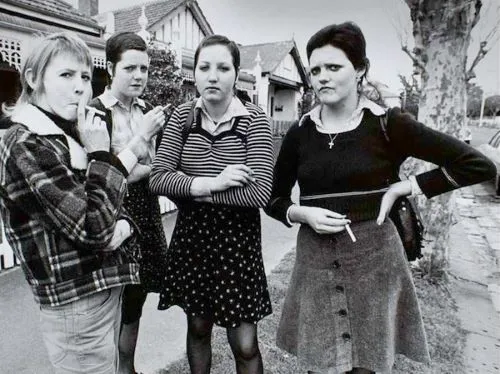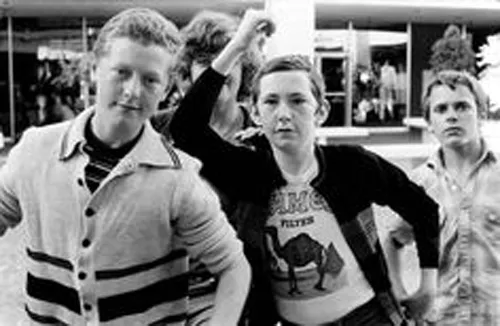Tracks and Into The Wild are studied as part of VCE English's Comparative. For one of most popular posts on Comparative (also known as Reading and Comparing), check out our Ultimate Guide to VCE Comparative.
INTRODUCTIONS
Into the Wild (2007) is a non-linear survival film directed by Sean Penn, which is based on Jon Krauker’s 1996 novel of the same name. It recollects the final few months of the life of Christopher McCandless as he departs from society in both an act of resistance as well as a means of self-discovery. A bright young college student in the 1990s, McCandless abandons his family and affluent lifestyle to embark on a frontier-style journey into the Alaskan wilderness. Troubled by a dysfunctional family and disenchanted with the materialistic excesses of 1980s America, McCandless seeks a radical engagement with nature, in the style of his literary heroes Henry David Thoreau and Jack London. After 113 days in the wilderness, he suffers from starvation and dies. The true story of McCandless’ journey renders the film an important depiction of self-reliance, isolation, and the unparalleled power of nature.
Whilst the film is of a biographical nature, it is important to understand that it is heavily subject to the interpretations and opinions of Penn. The story is informed by McCandless’ writings, and interviews with those who knew him, but is ultimately a work of artistic interpretation. Nonetheless, Penn’s film offers strong commentary regarding the materialistic, consumerist nature of modern living, whilst also ultimately emphasising the more humanistic importance of family and love.
Tracks is Robyn Davidson’s 1980 memoir detailing her perilous journey through 1700 miles of Australian outback and the remarkable character transformations that take place throughout. The events of the story begin in 1973, when a young Robyn Davidson arrives in Alice Springs with an outlandish plan to train wild camels to accompany her through the Australian desert. When, after two years of gruelling training, she receives a sponsorship from National Geographic, her journey can finally go ahead- on the condition that a photographer accompany her and document parts of the journey. This compromise weighs heavily on Robyn, as photographer Rick Smolan intrudes on her solitude and compromises everything the trip means to her. As Robyn delves deeper into the journey, each day brings new discoveries about the camels, the landscape, the people of Australia, and ultimately, her self. Tracks emerges as a candid and compelling story of one woman’s odyssey of discovery and transformation.
Whilst Tracks is mostly a personal account, it also presents a co-existent dichotomy between modernistic libertarianism and conventionalism, which serves as a reflection of the changing political views and ideological turbulence of the time, as Davidson notes ‘you could choose not to participate in politics, but you could not avoid politics’. Thus, in many ways Davidson’s journey can be seen as a firm statement that challenges the inherent sexism, racism, and ‘status quo’, whilst also simultaneously embracing the notion of freedom, independence, and escape from conventionalism and ‘self-indulgent negativity’.
THEMES
At LSG, we use the CONVERGENT and DIVERGENT strategy to help us easily find points of similarity and difference. This is particularly important when it comes to essay writing, because you want to know that you're coming up with unique comparative points (compared to the rest of the Victorian cohort!). I don't discuss this strategy in detail here, but if you're interested, check out my How To Write A Killer Comparative. I have used this strategy to create this themes table and throughout my character, views and values, and literary technique analysis.

CHARACTER ANALYSIS
Both Robyn Davidson and Christopher McCandless are products of the time period in which they live, and reject the concept of adhering to a predetermined notion of who they should be and how they should behave. Both embark on their journey because they reject the expectations of their class and gender.


AUTHORS VIEWS/VALUES
TRACKS
Women’s rights in 1970s Australia
Tracks is set in the late 1970s, an era of intense social and political change in Australia. The second wave feminist movements of the 1960s and 70s were enormously influential in Australia, as women began to dismantle the sexist structures inherent in Australian society at this time. Davidson describes Alice Springs as hopelessly in the grips of a ‘cult of misogyny’. She rejects the archetype of the passive, docile woman. She is passionately determined to shed her own sense of herself as traditionally “feminine,” a quality she sees as arising from being trained from birth to be “door-mattish”.
Davidson acknowledges her gender has played a central part in the media’s fascination with her journey. The character of the ‘camel lady’ that emerges suggests the significance of her trip, as a woman travelling alone in the 1970s through intensely difficult terrain. Davidson describes the late sixties and early seventies as a time of radical social time, when “anything and everything seemed possible, and when the status quo of the developed world was under radical scrutiny by its youth”. Thus Davidson’s actions must be considered in the context of this time, at the peak of the second wave feminist movement.
There are many explicit examples of Robyn facing misogyny and embodying feminist principles. One such example is when an Alice Springs local suggests she’s the “next town rape case”. This statement reveals the position of a woman in this misogynistic society, wherein a single woman travelling alone through the bush was synonymous with danger and irresponsibility. Davidson rejects this ideology and refuses to succumb to the violent sexism she encounters, or compromise her journey.
Tracks is not an explicitly feminist text, but it clearly echoes the philosophies of feminism. In the years since the trek, Robyn Davidson has become a feminist symbol of defiance, endurance and strength. Thus to consider Tracks from a feminist perspective is important when studying this text, Davidson’s criticisms of Australian misogyny inform our understanding of this historical context, and the significance of her actions.
Some example sentences:
- Davidson exposes the realities of misogynistic Australian culture in the 1970s.
- Davidson’s journey emerges as a defiant example of women’s strength and independence.
- Davidson’s friendship with Gladdy Posel suggests the injustices of women’s financial dependence on abusive men and condemns the limited options for women, particularly for those in rural settings.
- Tracks challenges the constraints of gender through a narrator that cannot be defined by stereotypical images of the domestic and passive female.
Indigenous Rights in Australia
The 1970s saw the first attempts to improve the lives and rights of indigenous Australians. In 1971 Indigenous people were counted in the census, and in 1976, the Aboriginal Land Rights Act was established. Davidson’s time with Mr Eddie exposes her to the harsh reality of the living conditions of Indigenous Australian’s throughout the 1970s, as well as inspiring a deep appreciation for the culture and connection with the land. Davidson is frustrated with the mistreatment of Indigenous people in Australia, and feels ambivalent about her status as a white, privileged, outsider in their community. Davidson confronts the racist and discriminatory stereotypes and attitudes towards Indigenous Australians, and experiences first hand the realities of the issues these people face. Davidson encounters intense generosity and friendship in the Indigenous community that she admires and presents as a stark contrast to the intolerant attitudes of white Australians in Alice Springs.
Quotes:
- “The blacks were unequivocally the enemy – dirty, lazy, dangerous”
- “Aborigines. Warm, friendly, laughing, excited, tired Pitjantjara Aborigines...” (p. 155)
- “Ceremonies are the visible link between Aboriginal people and their land. Once dispossessed of this land, ceremonial life deteriorates, people lose their strength, meaning and identity.” (p. 167)
Some example sentences:
- Davidson renegotiates her identity and relationship with the land after learning from the Indigenous Australians.
- Davidson condemns the racist attitudes of white Australians towards the aboriginal people.
- Davidson embodies the changing attitudes of young Australians towards aboriginal Australians, endorsing a respectful relationship with the traditional land owners.
INTO THE WILD
Social criticism of materialistic excess
While Into the Wild is set in the 1990s, McCandless’ formative years were the 1980s – a decade characterised by the consumerism, extravagance, and materialism of President Reagan’s America. The reverberating effects of this time period inform McCandless’ general outlook and disdain for American society. Whilst this contempt for consumerism is one motivation for McCandless’ actions, he is equally troubled by the family violence and dysfunction he experienced as a young man. This traumatic past informs his extreme actions and outlook.
Example sentences:
- Penn exposes the effects of materialistic society on young impressionable people.
- Penn explores the consequences of experiencing childhood trauma, and how this manifests in adult actions.
- Penn condemns the expectations of 21 st century nuclear families.
- Penn endorses the liberating power of familial love and relationships.
Depiction of the unparalleled power of nature and man’s inability to contend with it
Inspired by Thoreau and London, Chris seeks enlightenment in the wild. Despite a philosophical understanding of the power of nature, Chris believes he can survive the untamed wilderness of Alaska. Although nature is the locus for self-realisation and growth for Chris, it is also what destroys him. As the viewer watches him slowly deteriorate, we come to fully comprehend the force of nature – suggesting man’s inability to control it.
Some example sentences:
- Penn’s depiction of McCandless’ deterioration suggests human’s inability to control nature.
- Penn endorses the liberating power of literature, but cautions the idealism contained within romantic depictions of nature.
LITERARY TECHNIQUES
Narrative Voice
An important aspect of Into the Wild to consider is that McCandless’ story, while true, is told through Sean Penn’s directorial lens, which is in turn based on Jon Krakeur’s book. The story is informed by McCandless’ writings, and interviews with those who knew him, but is ultimately a work of artistic interpretation. Consider how this affect’s a viewer’s perception of Chris, does this raise questions around representation and identity? This is in direct contrast to Tracks, which is a first person, linear past tense, autobiographical account of the writer’s experience. Where Robyn is completely in control of her narrative, McCandless’ is subject to the artistic interpretation of others.

SYMBOLS

Anthropomorphism
Anthropomorphism is defined as the attribution of human characteristics or behaviour to a god, animal, or object. Robyn repeatedly personifies the animals she encounters. The camels in particular take on their own human personalities in her life. This technique, called anthropomorphism, can be used to complement a discussion of the theme of isolation. Robyn attributes distinct characteristics to each camel, suggesting her need for companionship and the powerful absence of human connection in prolonged periods of isolation.
Davidson’s depiction of her dependence on animals reveals deeper meanings about her inability to depend on, and communicate with, humans in the same way. Robyn’s reliance on her dog, Dookie, becomes more intense as the journey continues. Upon Dookie’s death, both the reader and Robyn experience the dog’s death as a powerful blow.
Examples:
- “I am quite sure Diggity was more than a dog, or rather other than dog. (p. 207)”
- “But I said goodbye to a creature I had loved unconditionally, without question. ... I walked out into the morning and felt nothing. I was numb, empty. All I knew was I mustn‟t stop walking. (p. 223) ”
- “Diggity had become a cherished friend rather than simply a pet. (p. 227)”
- Kate: “remembered humans and hated them”
- Zeleika: “had a lovely gentle nature” “the street-smart, crafty, unfazable, self-possessed leader”
- Dookie: “nominally king, but if anything untoward happened he was the first to hide behind Zeleika’s skirts”
- Goliath: “cheeky, pushy, self-centred, demanding, petulant, arrogant, spoilt and delightful”
SAMPLE PARAGRAPHS
Prompt: Discuss the ways in which the environment assists the protagonists in their journey for self-discovery.
Introduction: In forging connections with the environment and people around us, humans end up inadvertently discovering themselves. It is this notion that resonates throughout both Robyn Davidson’s 1970 memoir, Tracks, and Sean Penn’s 2007 film, Into the Wild, where the relationships that the protagonists form throughout their journeys leads to intense self- discovery and growth. Both Davidson and McCandless seek knowledge and guidance through both the individuals they meet and, specifically to McCandless, the books he reads, citing it as a means of grappling with the fundamental stages of self-discovery. Whilst Davidson and McCandless experience different relationships with their immediate family, it is ultimately the concept of family that underpins their motivations and inspires them to pursue their journeys – both physical and psychological. Further, the respective temporal environments in which both protagonists are immersed in emerge as a distinct theme that facilitates each stage of self- discovery in the climatic lead up to the ultimate self-realisation.
Body Paragraph 1: Both Into the Wild and Tracks endorse the guiding power of influential figures on both protagonists, as a catalyst for their growth. Davidson commences her self-described ‘lunatic’ journey with little knowledge of the wild to substantiate her mammoth ambition. That her drive outweighs her preparation manifests in the early moments of the text, wherein Davidson endures a grueling internship with the impulsive ‘maniac’ Kurt Posel. This man appears the epitome of the ‘biased, bigoted, boring and above all, brutal’ man she describes as the stereotypical ‘Aussie male’. Kurt is abusive to both Davidson and his wife, but his eccentric and impulsive ways expose her to the harsh realities of bush living. Ultimately, Kurt’s guidance allows Davidson to gain the fundamental skills she needs to train camels, whose dispositions reflect the erratic nature of Kurt himself. In direct contrast to this tense, exploitative relationship, is Davidson’s nuanced and spiritually rewarding relationship with Mr. Eddie, an aboriginal elder whom she describes as a “sheer pleasure to be with”. Despite an ostensible language barrier, Eddie’s instruction of the Indigenous Arts and Culture leave an impressionable impact on Davidson’s character and personality. By accepting Eddie’s guidance at a pivotal point in her journey, Davidson’s ambivalent sense of self, the overwhelming feeling of being an imposter, is diminished. Davidson becomes more grounded and connected to her environment; the knowledge that she derives from key characters contributes to a distinct conformational change in her personality and thus critically assists her in developing a strong sense of one self. A similar theme resonates in Into the Wild, where Chris McCandless heavily relies upon the guidance of various prominent figures he meets throughout his journey as well as ‘the characters of the books he loved from writers like Tolstoy, Jack London and Thoreau’ whose words he could and often would ‘summon….to suit any occasion’. The fact that McCandless readily referred to the words of the likes of Tolstoy, London, and Thoreau amidst times of mental angst and challenge, is a significant reflection of not only the quintessential teacher and student relationship he shares with them, but also the level of impact they have had in shaping in the ideological processes that define Chris’s values and sense of oneself. This very idea is furthered by Sean Penn when he depicts Christopher McCandless quoting soviet Russian poet, Boris Pasternak, suggesting that humans ‘ought to call each thing by it’s right name’, following which he acts impulsively and with great haste, engineered with rapid and distorted camera movements. In doing so, Penn illustrates the importance that Chris places upon the words of such idealists to the stage where he acts upon their advice without giving them proper consideration within his literal, temporal context. The protagonists of both Into the Wild and Tracks, both rely upon the knowledge and guidance of individuals, be they physical or via literature, as a means of grappling with their fundamental understanding of the human spirit and in doing so their intricate understanding of themselves.
Body Paragraph 2: Both texts demonstrate a degree of discontentment and resent towards the institutionalized, '20th century convention' of family. Davidson describes the notion of family as “invisible ropes and chains” of guilt, she comments that families lack for the most part, a true sense of love. This sentiment is starkly contrasted with Davidson’s intense engagement with the wild, which she describes in the language of love and connection. “I love you. i love you sky, bird, wind, desert, desert, desert’ proclaims Davidson, as she describes having “no more loved ones to care about” and “no more ties” to bind her to material existence. Davidson laments the distortion of her journey for public consumption, stating “so far people had said that i wanted to commit suicide, that i wanted to do penance for my mother’s death…” this comment is one of the only references to her mother’s suicide, which can be interpreted as a catalyst for her ambivalence about the notion of family. This experience evidently informs Davidsons’s somewhat impenetrable exterior and suggests a deeper complexity to her resistance of 20th century societal expectations. Similarly, Christopher McCandless articulates a powerful contempt for family. McCandless feels impeded in his personal motivations by the familial concepts of ‘graduating college’ and ‘getting a job’ which he describes as “20th century inventions” inextricably linked with “this world of material excess”. McCandless expands on this point, commenting that his pursuit for self-discovery has ultimately resulted in ‘the killing of the false being within’, the ‘false being’ that was bound to the societal expectations and the material conventions of the time. Chris’ departure into the wild is as much of an act of punishment for his family, as it is about Chris discovering true freedom and metaphysical spirituality. It is this idea of ‘telling the world’ of his family’s misdeeds that continually motivates Chris to continue on with his journey, which is depicted by Penn through the countless solo enactments and impersonation of both Chris’ mother and father, often depicting a negative experience which has quite evidently scarred his ‘crystal like’ mind. Family is thus, a primary motivation for both key characters within Tracks and Into the Wild to firstly partake on their journey, but more significantly to discover an uncorrupted, unbiased ‘true’ version of them that had been lost amidst ‘this world of material excess’.
Conclusion: Both Tracks and Into the Wild explore the inextricable link between ones environment and their personal growth. Nature is emphasised as a world removed from the materialistic excess of modern urban life, in which one can engage with an alternative, radical set of values. Both Davidson and McCandless escape from the confinements of their lives and experience profound transformations over the course of their journeys. Thus, both Davidson and Penn comment on the omniscient, multifaceted nature of the environment around a person being instrumental in moulding each stage of the journey of self-discovery and transformation.
*A big shout out to Suraj Hari, 2017 graduate and currently studying Medicine in Tasmania, who is a contributing author of this blog post.





.png)





.jpg)